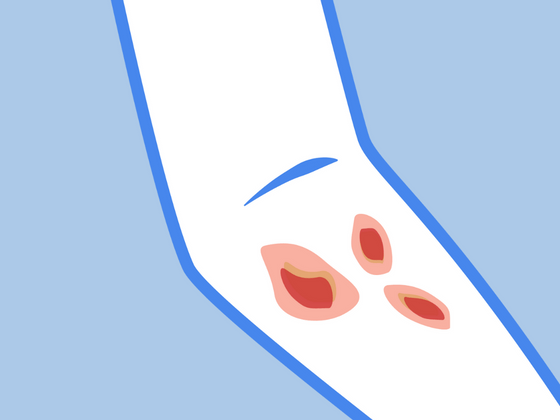Eczema often flares up in problem areas where skin touches the skin, like inside the elbows or behind the knees. One of the most annoying and possibly embarrassing areas to get eczema is the groin. The region is a warm, moist place, making it the perfect breeding ground for infections and rashes.
Groin eczema, also known as groin dermatitis, is widespread and has symptoms similar to eczema affecting other body parts. These eczema symptoms may include:
- Dry, scaly skin
- Itching
- Redness or discoloration
- Broken hairs
- Weeping skin, blisters oozing clear fluid
- White spots
Groin eczema is sometimes mistaken for jock itch, a fungal infection known as tinea cruris. However, unlike jock itch, groin eczema:
- Is a chronic condition
- Not contagious
- May lead to thick, leathery skin
- May not have patches with clearly defined edges
A doctor can usually diagnose eczema by looking at the rash, but they may need to examine the skin by scraping off a small sample for fungal testing or performing a skin biopsy. In addition, many conditions, such as yeast infection or skin infections, allergic contact dermatitis, psoriasis, lichen planus, and others, can affect the groin. Therefore, seeking a medical opinion can help get a proper diagnosis and recommendations for appropriate treatment for quicker relief.
Below are some suggestions to help prevent and soothe groin eczema:
Switch Your Underwear
Avoid irritating chemicals, fabrics, or latex bands to keep sensitive body regions clean and dry. We recommend our allergy-free underwear. Below are some great 100% organic cotton and latex-free options to soothe groin dermatitis like vaginal dermatitis.
- Women’s Bikini Briefs
- Women's Drawstring Elastic Free Panties
- Women’s Waist Briefs
- Women's High Cut Panty
- Men’s Elastic Free Drawstring Boxers
We also really love these Remedywear™ boxer briefs. They are made with TENCEL and zinc, clinically proven [1] to reduce inflammation and itchy skin in just three nights! Furthermore, study participants reported improved sleep quality, daytime pruritus (itchiness), and daytime functioning.
Soothe with a Natural Cream or Balm
Groin dermatitis can cause itching and inflammation, so washing the skin with a gentle, specially formulated soap and using a natural cream with healing ingredients can help with symptoms. Avoid creams with fragrances or harsh oils, which can promote allergic contact dermatitis (an allergic reaction) in sensitive skin.
We recommend our Emily Skin Soothers Hot Skin Soother. This sunflower seed oil-based balm is a popular option for dermatitis. Studies show sunflower seed oil can reduce skin redness, water loss, and infections in kids with eczema [2][3].
Try Wet Wrapping
This quick and effective technique works on any part of the body. Soak in water for twenty minutes; towel dry, apply cream of choice, cover with a damp layer of clothing, and then top with a dry layer of clothing.
An alternative to wet wrapping is simple dry wrapping, which achieves similar results without the mess of damp clothing. In dry wrapping, patients cover the skin with an emollient and then apply specially-designed wraps and garments to facilitate deep, long-lasting penetration of the product. Also, check out Remedywear™ clothing for eczema which can be used for dry wrapping.
For all patients with inflammatory skin conditions such as eczema, we recommend a plant-based diet rich in minimally processed foods (think things that don’t come in a package or have more than five ingredients). For more information and tips, see How To Get Rid of Eczema Naturally.
Further Reading:
[1] Wiegand, 2013, Skin-protective effects of a zinc oxide-functionalized textile and its relevance for atopic dermatitis. Clin Cosmet Investig Dermatol; 6: 115–121. https://www.ncbi.nlm.nih.gov/pmc/articles/PMC3656…
[2] Eichenfield LF, McCollum A, Msika P. The benefits of sunflower oleodistillate (SOD) in pediatric dermatology. Pediatr Dermatol. 2009;26(6):669-675.
[3] Darmstadt GL, Mao-Qiang M, Chi E, et al. Impact of topical oils on the skin barrier: possible implications for neonatal health in developing countries. Acta Paediatr. 2002;91(5):546-554.
[4] Fowler, J. F., Jr., Fowler, L. M. & Lorenz, D. Effects of Merino Wool on Atopic Dermatitis Using Clinical, Quality of Life, and Physiological Outcome Measures. Dermatitis: contact, atopic, occupational, drug 30, 198-206, doi:10.1097/DER.0000000000000449 (2019). https://www.ncbi.nlm.nih.gov/pubmed/25607551
------------------

Author
Bio: Laura is a contributor and content developer for The Eczema Company. She is in no way a medical professional. Her comments, suggestions, and reflections are not intended to replace any medical advice. Always seek the help of a medical professional before undertaking any diet or lifestyle changes.

Bio: Dr. Joanna "Asia" Jaros is a current Dermatology resident at Cook County Hospitals and Health System (CCHHS). Dr. Jaros is committed to providing compassionate, equitable, and evidence-based care for all of her patients. Her special research interests include eczema, chronic urticaria, and diet and lifestyle modifications in dermatology.








